“I go to seek a Great Perhaps”: engaging youth audiences AOIBHIE McCARTHY
Introduction1 Ireland has one of the youngest populations in the European union and yet, young people form just 10% of Irish exhibition audiences2. The received wisdom, Mulhearn tells us, is simply that ‘“museums and teenagers don’t mix”3
—
As Article 27 of the united Nation’s universal Declaration of Human Rights states, everyone has the right freely to participate in the cultural life of the community”4. In facilitating the exercise of that right, The Council of National Cultural Institutions’ Policy Framework for Education, Community and Outreach acknowledges that, as publicly funded institutions, we have a “particular responsibility in respect of children and young people”5. This research study interrogates the received wisdom – the notion that teenagers are a lost generation to museums and galleries – to explore the potential of such institutions in enabling young people to become active custodians of Irish cultural life.
1. This article is adapted from a presentation made at the Irish Museums Association Education and Outreach Forum on 27 June 2014, Dublin. 2. Arts Audiences (2012) Arts Attendance in Ireland 2012. Accessed December 14, 2012, from http://artsaudiences.ie/wpcontent/uploads/2012/11/Arts-Att endance-in-Ireland-2012.pdf , 18 3. Mulhearn, D. (2010) Teenage Kicks. Museums Journal 110: 34 4. United Nations (1948) The Universal Declaration of Human Rights. Retrieved March 13, 2014, from http://www.un.org/en/document s/udhr/ 5. Council of National Cultural Institutions. (2004) Policy Framework for Education, Community, Outreach: Policy Framework for Education, Community, Outreach. Dublin, 14
This practice-based research study, conducted through the Shinnors Curatorial Scholarship, involved the author, as Curator of Education, working with young people from 12-23 years in Limerick City Gallery of Art (LCGA), to examine the impact of a variety of formats for effective youth audience engagement. This article will present the findings arising from this dynamic youth programme, which culminated in The young Curatorial Programme- an exploration of the potential of youth participative practice and the involvement of young people in the curatorial process. In addition, this article will present the experiences and insights of other gallery and museum-based professionals in creating genuine access for youth audiences – examining particularly the challenges and benefits which both young people and institutions experience. This article will also present the findings of a consultative process with young people themselves in which members of The Butler Gallery kilkenny’s Red Square youth
‘‘I go to seek a Great Perhaps’’: engaging youth audiences
111













